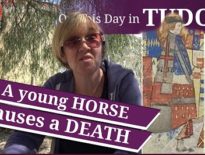On this day in Tudor history, 14th March 1555, courtier, envoy and landowner, Sir John Russell, 1st Earl of Bedford, died at his London residence on the Strand aged around 70.
Russell was an important Tudor man who served four Tudor monarchs - Henry VII, Henry VIII, Edward VI and Mary I - AND he managed to keep his head, dying a natural death at a good age.
Find out more about this Earl of Bedford, his life, his rise and his career at the royal court, in today's talk.
Also on this day in Tudor history, 14th March 1540, Sir John Port died at Bewdley. Port is remembered for mumbling in a case and changing the outcome, and you can find out more about what happened in last year’s video:
Also on this day in history:
- 1471 - Death of Sir Thomas Malory, known for his work "Le Morte d'Arthur", which he wrote in prison. He was laid to rest in St Francis's Chapel, Greyfriars, Newgate.
- 1553 – Death of Arthur Bulkeley, Bishop of Bangor, at his home in Bangor. He was buried in the cathedral choir.
Transcript:
On this day in Tudor history, 14th March 1555, courtier, envoy and landowner, Sir John Russell, 1st Earl of Bedford, died at his London residence on the Strand aged around 70.
Russell was an important Tudor man who served four Tudor monarchs: Henry VII, Henry VIII, Edward VI and Mary I.
Let me tell you a bit more about his life and career.
Russell was born in around 1485 in Dorset and was the son and heir of James Russell of Kingston Russell, Dorset, and his first wife, Alice Wise. His father died in late 1505 or early 1506, but Russell did not inherit until 1523, on the death of his father’s second wife, Joan.
Nothing is known of Russell’s early life, but he obviously had a good education as he was fluent in both French and Italian. He was appointed as a gentleman of the chamber to King Henry VII in 1507 and was a gentleman usher at the king’s funeral in 1509.
Russell was a keen jouster, taking an active part in the sport in the 1510s, making him popular with the new king. In 1513 he was serving as a gentleman usher of the king’s chamber and he served the king in the French campaign of 1513. He attended the marriage of Mary Tudor and King Louis XII in France in 1514 and began working for Cardinal Thomas Wolsey as a diplomat around this time. He accompanied the royal party to the Field of Cloth of Gold in 1520.
Russell lost the sight of his right eye while serving under the command of Thomas Howard, Earl of Surrey, in naval operations against France in 1522. He was, however, rewarded for his courage by being knighted that same day. In 1523, he was made knight marshal of the household, and in the same year he served as a special ambassador in France and carried out further diplomatic missions in the 1520s. He also fought with the Duc de Bourbon, Constable of France, against the Empire at the 1525 Battle of Pavia, reporting back to Wolsey and the king. During Wolsey’s purge of the king’s privy chamber of 1526, Russell was was rewarded by the cardinal by being named as a gentleman of the privy chamber. He also carried out a diplomatic mission to Pope Clement VII in 1527.
In around late 1525, Russell married Anne Jerningham, daughter and heir of Sir Guy Sapcote, and widow of John Broughton and Sir Richard Jerningham. It was a good match for Russell was in royal favour and Anne brought three manors to the marriage, including Chenies in Buckinghamshire, which became their home. The couple received a further manor in Buckinghamshire as a wedding gift from King Henry VIII. Russell and Anne had one child together, Francis, born in around 1526/7.
By 1527, Russell was a knight of the body, but his support of Cardinal Wolsey through his fall, meant that he was not favoured by Anne Boleyn, the king’s sweetheart. He accompanied the king and Anne to Calais in October 1532, on their visit to meet with Francis I, but then focused on more local issues, serving as a Justice of the Peace for several counties.
In 1536, he attended the wedding of the king and Jane Seymour and wrote to Lord Lisle “kyng hath come out of hell into heaven for the gentellness of this and the cursidness and unhappyness in the other”, referring to Jane and Anne, and he helped put down the Pilgrimage of Grace Rebellion. He was made comptroller of the royal household in October 1537 and he and his wife were given jewels belonging to Jane Seymour following her death that month. He was very close to the king at this point, with Baron Darcy writing that Russell was of a minority that would “dare and wyll speke to the king the tryth”, which he did in 1544 when he called the king’s French campain a “wyld war … without any gayne”. The king rewarded him for his loyalty and long service in 1539 by making him Baron Russell. He was also elected as a Knight of the Garter, made Lord President of the Council of the West, steward of the duchy of Cornwall and lord warden of the stannaries, AND granted former monastery lands in Devon, which doubled his income, making him incredibly rich.
Following the fall of Thomas Cromwell in 1540, he was made Lord High Admiral and then, in 1542, Lord Privy Seal and High Steward of Oxford University.
In November 1541, Jane Boleyn, Lady Rochford, who had been arrested for her part in Catherine Howard’s fall, was sent to Russell’s residence on the Strand, after she had shown signs of madness while imprisoned at the Tower of London. There, Russell’s wife, Anne, was to take care of her and the king’s physicians were sent to her too. Jane was sent back to the Tower in February 1542, where she was executed.
In 1544, Russell commanded the vanguard in the French campaign, and then served as Lord Lieutenant back in England in 1545.
Russell was an executor of Henry VIII's will, receiving a personal bequest of £500, and served as high steward at Edward VI’s coronation in 1547, and carried on as Lord Privy Seal. In 1548, Russell warned Edward VI’s uncle, Thomas Seymour, against his plan to marry the king’s half-sister, Princess Elizabeth, and gave evidence against Seymour at his fall in 1549. In the summer of 1549, Lord Protector Somerset sent Russell to the south-west of England to suppress the Prayer Book Rebellion, which he did along with Sir William Herbert and William Grey.
Russell supported the coup by John Dudley, Duke of Northumberland, against Lord Protector Somerset in 1549 and was rewarded with lands and the earldom of Bedford. He was an active privy councillor under Northumberland. He was, however, reluctant to support Lady Jane Grey as queen in July 1553 and turned to Mary’s side. He served the new queen as Lord Privy Seal and helped protect London against the rebels of Wyatt’s rebellion in 1554, although his son was implicated in the rebellion. Fortunately, Francis was pardoned in September 1554. Russell also travelled to Spain as a special ambassador to make arrangements for Mary I’s marriage to Philip of Spain, which he attended in July 1554.
In January 1555, Russell attended his last privy council meeting, and on 2nd February he drew up his will. He died on this day in 1555 and was buried in St Michael’s Church, near the family home of Chenies. His wife, Anne, commissioned the Bedford Chapel there, in accordance with Russell’s will, and it was built in 1556. Anne was buried with her husband after her death in 1559 and they have a tomb chest monument topped with effigies. Their son, Francis, inherited his father’s earldom, becoming 2nd Earl of Bedford.



Leave a Reply